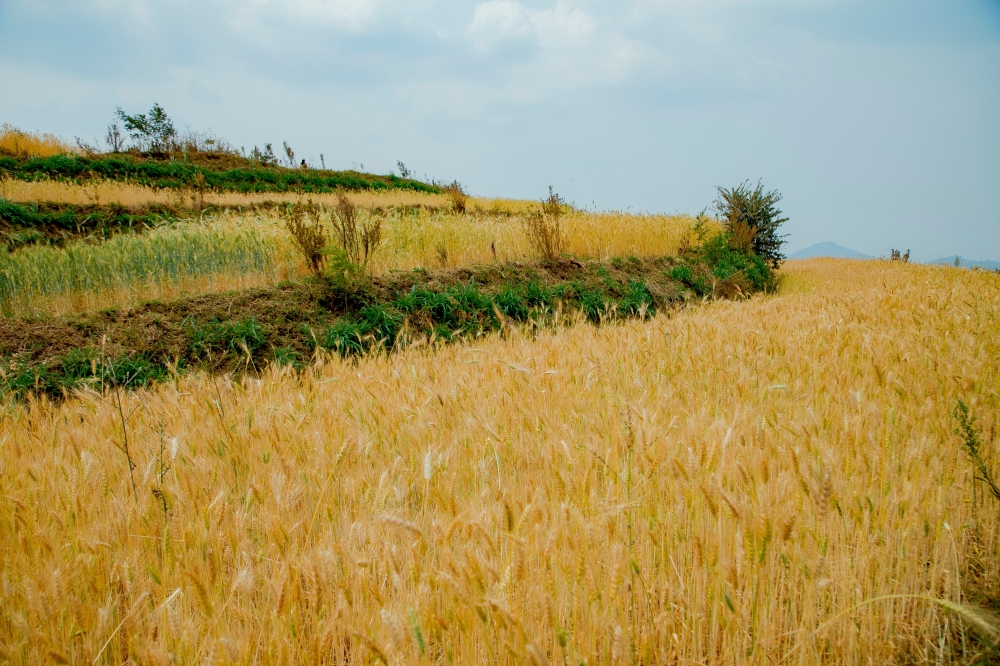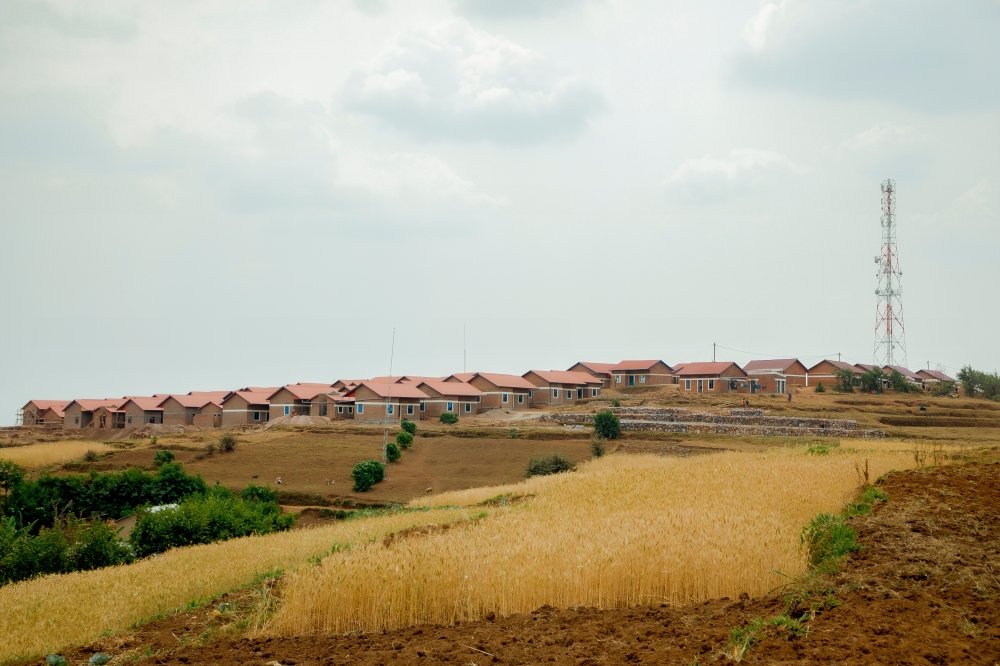

Farmers like Saidat Nyirambonimpa from Gatore sector in Kirehe District had for long faced declining crop yields and worsening living conditions due to climate change effects but the situation has since turned around.
The Landscape Restoration Approach to Climate-Proof the Rural Settlement (also known as LDCF3 Project) has built resilience to climate change in Kirehe and Gakenke districts.
The six-year project launched in 2022 is implemented by Rwanda Environment Management Authority (REMA), Kirehe District in Eastern province and Gakenke District in Northern Province with technical and financial support of the Global Environment Facility (GEF) and the United Nations Development Programme (UNDP).
The project aims at supporting rural communities that are feeling the effects of climate change in Rwanda where the landscape is marked by rolling hills and fertile valleys and it focuses on restoring ecosystems to build resilience, improve livelihoods, and bring hope to communities in these districts.
The LDCF3 Project has improved agricultural productivity through terracing and livestock distribution.
Nyirambonimpa recalls her initial doubts about the terraces introduced by the LDCF3 Project.
"I was hesitant about the terraces, but now I am a community mobilizer, sharing the positive impacts I’ve experienced. Before, I could barely harvest half a bag of beans, but now I have harvested five bags. The fodder plants on the terraces also provide ample feed for my livestock, significantly improving our livelihood,” she said.
Many farmers in Gakenke and Kirehe Districts agree that the terraces have reduced soil erosion and increased agricultural productivity.
"The LDCF3 Project created terraces on my land that was once devastated by erosion. I was hesitant at first, but now I’m grateful. The terraces have boosted my wheat production tenfold! I can’t thank the project enough for transforming my farm and my future,” said Francois Simpunga, a farmer from Muzo Sector in Gakenke District.
In addition to building terraces, the LDCF3 Project has provided livestock, including goats, sheep, and pigs, to beneficiaries in both districts. These animals not only offer food and income but also produce manure that enriches the soil, further boosting agricultural productivity.


"Through the LDCF3 Project, I have received life-changing support. The terraces have transformed my farming practices, and the wheat crops they produced have given me hope for a good harvest. The goat I received not only helps my family but also provides manure that keeps my land fertile,” noted Gabriel Munyazesa, a resident from Muzo Sector in Gakenke District.
Farmers are now enjoying abundant harvests, contributing to food security and better incomes for their families.
Connecting communities through infrastructure
In Gasharu village, the LDCF3 Project has also addressed important infrastructure needs. A new road now connects the previously isolated village to other parts of the district, opening up economic opportunities and increasing land value.
"Before the LDCF3 Project, we were cut off, especially during the rainy season when the bad road made travel nearly impossible. Now that the project has built a road connecting us to other parts of the district, our lives have improved, children are proud to go to school, and the value of land in our sector has risen,” Nsengimana Kubwayo, a resident of Gasharu village in Kirehe District, said.
The LDCF3 Project has connected 214 homes in Gasharu village to electricity, which has been a game-changer for local communities, especially for children.
"Thanks to the LDCF3 Project, Gasharu village is now connected to electricity! We were isolated without it, but now our land's value has soared, and people are eager to buy plots here. Importantly, our children can now study and do their homework at home, improving their performance at school. The future looks bright!” testified Jean Claude Kubwayo, a resident of Gasharu village in Kirehe District.
Improving communities’ livelihoods
Another significant intervention by the LDCF3 Project is providing improved cookstoves. These stoves help reduce fuel use and lower indoor air pollution, which can lead to respiratory issues.
"The improved cookstoves distributed to us by the LDCF3 Project have been a game-changer! They save energy, allowing us to cook meals without spending much on firewood, which used to be so expensive. This not only helps our pockets but also protects our forests, contributing to the fight against climate change,” said Jeanne Mukatwizeyimana from Gatore Sector.
For many beneficiaries in the Kagano and Nyabigega model villages in Gakenke and Kirehe Districts, the LDCF3 Project’s green villages initiative has been life-changing. Those who were moved from high risk zones now have decent homes built by the project.
"Thanks to the LDCF3 Project, my family and I were relocated from high-risk zones to a safe and sustainable home in Kagano rural settlement. This has not only given us security and peace of mind but has also opened up new opportunities for me to engage in income-generating activities, transforming our lives for the better,” said Aline Nzamwita from Kagano village.
Creating green jobs and empowering communities
The LDCF3 Project also focuses on creating green jobs, especially for women and young people. These jobs involve tree planting, terracing, building, and maintaining the infrastructure built by the project.
Through restoring ecosystems and promoting sustainable practices, the project is helping communities in Gakenke and Kirehe Districts become more resilient and hopeful, according to Juliet Kabera, Director General of REMA.
"The LDCF3 Project has had a profound impact on the lives of our beneficiaries, enhancing their resilience to climate change and improving their livelihoods through sustainable practices. We have seen communities transform through the restoration of ecosystems, improved agricultural productivity, and the creation of green jobs. As we move forward, REMA urges all beneficiaries to take ownership of these initiatives and sustain the project’s activities. Together, we can ensure that these gains continue to benefit future generations and contribute to a more resilient Rwanda,” she noted.
The six-year initiative that aims to put Rwanda’s Rural Settlement Programme (Imidugudu) on a climate-resilient pathway, promote nature-based solutions and biodiversity protection, by controlling erosion on hillsides, planting agroforestry trees, planting forests and protecting riverbanks.
The UNDP Resident Representative, Dr. Fatmata Lovetta Sesay noted that "In districts like Gakenke and Kirehe, where the rural poor are most vulnerable to climate change, the restoration of degraded ecosystems and the promotion of grouped rural settlement serve as foundational strategies for sustainable development, offering hope and resilience to those who need it most.”
The LDCF3 Project is establishing a solar-powered irrigation system covering 100 hectares in Musaza Sector, Kirehe District, to support local communities in adapting to climate change. This initiative aims to enhance agricultural productivity by providing a sustainable water supply, reducing farmers' dependence on erratic rainfall.
A glance at LDCF3 projects achievements to date
Under the project, at least 2,100 hectares of land were managed by controlling erosion through creating progressive terraces and planting agroforestry.
According to the report 3,200 households were provided with livestock such as pigs, sheep and goats) in Gakenke and Kirehe districts to improve their livelihoods.
Around 10,000 green jobs were created by the project through ecosystem restoration and development of green rural settlement while 5,000 households were provided with improved cookstoves to reduce pressure on forests and cut down emissions.
It shows that 136 houses are under construction to climate-proof the rural settlements while 214 Households were connected to electricity.


